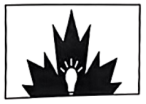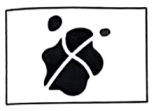When Alex Petrie went to stay with his father, he noticed that the 75-year-old walked around several times during the night. This was worrying: his father lived alone and had recently been diagnosed with Lewy body dementia (路易体失智症).
“I was feeling quite nervous about it and wondered if he was doing it every night,” says Petrie. “It‘s not nice to think that he's worried or can't sleep properly.”
But Petrie had recently installed (安装) a smart home system, Howz, in his father's flat. It uses sensors to track movements, feeding the data into an app that family members and close friends can access. Once the Howz system has analysed and established someone's habitual way of doing things, it will send alerts (警报) to the app if there are any changes. For example, if a sensor usually senses movement before 8 am each day — signalling the time the person normally gets up — an alert will be sent if there has been no movement by that time. Relatives can then call in to make sure everything is okay.
Using the app, Petrie could see that his father usually got a good night’s sleep and very rarely walked about during the night. With this knowledge, he was able to provide the right kind of support and care when his father did have a sleepless night.
Howz, which was developed by Intelesant, a Manchester-based health tech company, aims to help people live independently in their own homes and provide peace of mind for their relatives.
Petrie set up two sensors in his father’s flat: one on the front door and another in the hall. “The door sensor is important as I can see whether his carers have visited. It doesn’t tell me who has visited but it’s easy to find out by the time of the day. The sensor in the hall covers the most commonly used area of the flat. It gives us a near-continuous view of whether he's up and about. It’s a little safety net,” says Petrie.
1. What was the problem with Petrie’s father?| A.He insisted on living alone. |
| B.He didn't like the care home. |
| C.He always went out for a walk at night. |
| D.He sometimes couldn’t fall asleep at night. |
| A.How Howz works. |
| B.How Howz is tested. |
| C.Who invented Howz. |
| D.Why Howz was created. |
| A.It isn’t privacy-friendly. |
| B.It isn’t safe enough. |
| C.It is quite helpful. |
| D.It is big business. |
| A.Tech shortens the distance between people. |
| B.Tech is benefiting people’s daily life. |
| C.Tech affects the way people work. |
| D.Tech is slowing down aging. |
相似题推荐
【推荐1】Scientists have developed a fingerlike device that maps an object’s internal structure in 3-D by touching its surface. “This bionic finger has exciting application prospects in material characterization and biomedical engineering,” says Zhiming Chen, an engineer at China’s Wuyi University. “The technology could also be combined into robots and medical fields, which is our next research topic.”
The new “finger” contains a carbon fiber tactile sensor (触觉传感器), which returns a stronger signal when pressed against firmer objects. The device moves across an object’s surface to feel for increasing levels of pressure. This process can reveal subsurface details, such as hard layers inside soft er materials. “When pressed by this bionic finger, hard objects maintain their shape, whereas soft objects de form when sufficient pressure is applied,” says Jian Yiluo, the study’s senior author. “This information is sent to a computer, along with the recorded position, and displayed in real time as a 3-D image.”
Other imaging methods, including X-ray, PET, MRI and ultrasound, have their own advantages and disadvantages. X-ray s carry health risks, and other options lack portability or speed. Many are expensive. The new device is unlikely to be significantly cheaper than ultrasound, but it may provide better resolution (清晰度).
In man-made human tissue, the device can exactly find bones and a blood vessel (血管). For a flexible electronic circuit enveloped in soft material, it detected a circuit break and an incorrectly drilled hole. “When we make those devices, we always worry that if something is broken, the only way you can know is to take it apart,” engineer Subramanian says.
The device will struggle to map objects whose outer surfaces are too hard, and it may miss details underneath hard layers. The researchers plan to extend their invention into more dimensions, however, perhaps exploring from other directions as well. “This system might be expanded to multiple fingers, just like our hands, to realize detection in all directions,” Chen says. “This would enable it to get more complete information.”
1. What does Zhiming Chen think of the fingerlike device?| A.Convenient. | B.Promising. | C.Popular. | D.Complicated. |
| A.How the new finger works. | B.What benefits the finger brings. |
| C.Where the finger is applied. | D.Why the finger is welcomed. |
| A.It is cheaper. | B.It is quicker. | C.It is clearer. | D.It is safer. |
| A.The sense of direction. | B.The exploration of human hands. |
| C.The application field. | D.The detection accuracy. |
【推荐2】The International Federation of Inventors’ Associations (IFIA) holds around 50 events every year. Here is the information of some upcoming events.
Korea International Women’s Invention Exhibition (KIWIE)

KIWIE is truly one and only festival celebrating women inventors and inventions in the world, which has driven the growth of women inventors at home and abroad. This year, KIWIE 2023 will be held online and offline so that you can view the site and the online exhibition hall at the same time.
Date: July 20 (Thurs) — 22 (Sat), 2023
Place: Hall 4, Exhibition Center 1, KINTEX
International Invention Innovation Competition in Canada (iCAN)

iCAN 2022 last year featured more than 720 inventions from 81 countries around the world and was a true global stage for worldwide creativity and innovation. This year is a special online edition. You can send your application form and video file before 10th August 2023 by email.
Date: August 26 (Sat), 2023
Website: www. tisias. org
Macao (China) International Innovation and Invention Exhibition Expo (MiiEX)

MiiEX is the first and only contest showing various inventions and new products that are intended to go to the market. MiiEX offers a platform for communication among university students and inventors, through which students will get inspiration from interaction among participants.
Date: October 27 (Fri) — 29 (Sun), 2023
Place: Cotai Expo Hall D, The Venetian Macao (China) — Online and Offline Exhibition
Malaysia Technology Exhibition (MTE)

MTE focuses on recognizing inventions, programmes and ideas which contribute to sustainability, reducing poverty, improving area cooperation, protecting our planet, and building peace. The awards especially encourage the development of local solutions to local challenges.
Date: October 17 (Tues) — 21 (Sun), 2023
Virtual Event: www. mte. org. my
Place: Kuala Lumpur City Center.
1. Which of the following events is only available online this year?| A.KIWIE. | B.iCAN. | C.MiiEX. | D.MTE. |
| A.Macao people. | B.Market managers. | C.Women inventors. | D.University students. |
| A.Low-cost inventions. | B.High-tech inventions. |
| C.World-wide inventions. | D.Local-related inventions. |
【推荐3】Scientists have created the first lab-grown coffee, which they say “smells and tastes like the real thing”. The Finland-based researchers used a process called cellular agriculture, which includes taking out cells from a small plant or animal sample (样本). In the latest example of lab-grown options, cell samples were taken from Arabica, a popular coffee plant that makes up 56 per cent of global production. With lab-grown coffee, the researchers say that they can deal with problems facing the global coffee industry, such as a need for clearing space for coffee plants to keep up with an increasing need for the drink worldwide.
The research is being conducted at VTT Technical Research Centre based in Espoo, Finland—the country that drinks the most coffee per person. “The process uses real coffee plant cells,” Dr. Heiko Rischer, head of plant biotechnology at Finland’s VTT research center, said. “At first, a cell culture (细胞培养) is started from a plant part, for example, a leaf. The formed cells reproduced on a specific nutrient medium. In the end, the cells are transported to a bioreactor from which the biomass (生物量) is then harvested. The cells are dried and roasted then coffee can be brewed.”
The first collection produced by VTT in their laboratory smells and tastes like traditional coffee, according to the results of a “sensory analysis (感官分析)”. After drinking a cup, Dr. Rischer said, “There is a surprisingly full smell. In terms of smell and taste, our trained sensory judgement and analytical examination has found the coffee bears similarity to ordinary coffee,” he said. “The experience of drinking the very first cup was exciting. ”
The idea that coffee cells could be used to make coffee was presented back in 1974 by plant scientist P. M. Townsley. But the VTT scientists have put the theory into practice with their lab-grown brew, which they think could hit the market by 2025.
1. What might be one of the causes of creating lab-grown coffee?| A.There exists an increasing demand market of coffee. |
| B.People in Finland drink the most amount of coffee. |
| C.Dr. Heiko has been devoted to genetically engineering. |
| D.The idea is based on a theory proving to be practical. |
| A.Collected. | B.Designed. | C.Produced. | D.Measured. |
| A.Lab-grown coffee are all made from leaves. |
| B.Lab-grown coffee can satisfy the taste of most people. |
| C.Lab-grown coffee makes people who drink it more excited. |
| D.Lab-grown coffee tastes and smells better than ordinary coffee. |
| A.To praise scientists sticking with creation. | B.To present a research on man-made coffee. |
| C.To introduce a new kind of Arabica coffee. | D.To solve coffee shortage troubling people. |
【推荐1】Faced with greater competition, movie theaters have tried various experiments to upgrade the cinematic experience, including bigger and brighter screens and shaking seats. But a major challenge for exhibitors is to make the experience more attractive without depending on tricks.
One local theater, Regal L. A. Live, is experimenting with an idea that managers say strikes the right balance between so-called upgrade and sensory overload. The downtown L. A. theater plans to introduce Immersive Cinema Experience known as ICE technology in one of its auditoriums (礼堂) this fall.
The 190-seat auditorium will feature a traditional screen at the front, like any other theater. But the audience will also have five LED screens on both sides that will flood moviegoers’ peripheral (周边的) vision with lights and colors based on what’s playing on the main screen. For example, if you’re watching a scene that takes place in the African desert, the LED might shower the audience with enveloping colors of sky-blue, sun-like yellow sand. But importantly, viewers won’t have to turn their necks to catch any additional onscreen action. “When you’re watching the movie, you actually feel very absorbed in the film,” said Shelby Russell, a manager at L. A. Live. “It strengthens the mood of each of the scenes.”
Regal L. A. Live will be the first U.S theater to employ the technology. Managers did not say how much tickets would cost, but like other previous formats such as Imax, they will be more expensive than standard admission.
Other cinemas have tried to introduce some other formats as theaters face growing threats from popular media. Results have been mixed, though. 4DX, which uses seat movements, water and scent effects, operates in more than 620 theaters around the world. On the other hand, Barco Escape, a once promising idea for a three-screen theatrical design, failed to catch on. Shelby said the success of ICE theaters in France, where it competes with Imax, indicated well for its U.S. expansion. “The problem with other formats is that they distract the moviegoer from the film,” Shelby said. “ICE appeals to a very large audience.”
1. What leads cinemas to experiment with new technology?| A.Expensive admission. | B.Growing competition. |
| C.Mixed results of previous formats. | D.The increasing number of moviegoers. |
| A.Brighter colors. | B.Shaking seats. |
| C.Multiple screens. | D.Sweet-scented effects. |
| A.Absorbed in the movie. | B.Distracted from the screens. |
| C.Overloaded with excitement. | D.Tired from turning their necks. |
| A.Imax failed to catch on in France. | B.ICE looks promising in the U.S. |
| C.Barco Escape is a popular design. | D.The use of 4DX is on the decline. |
【推荐2】Stamp collection was once considered a harmless and educational pastime for small boys. It still is — but with a difference. Grandpa and grandma have joined the small boys, along with shoe clerks, waitresses, truck drivers, college professors , businessmen, presidents and kings. Stamp collecting has today grown into big business.
All the really rare old stamps are already owned by collectors who refuse to part with them. But even if these owners were willing to sell, few people could afford to buy.
A stamp becomes valuable because it is “ rare”. Modern collectors with little money to spend have to create their own “ rarities”. One rarity that stamp collectors look for is an error in the stamp. The error may be so small that it cannot be seen with the naked eye. If it is there, however, it makes the stamp more valuable.
Stamp collectors have another way of making their collections rare or unusual. They bring together as many examples as they they can of a certain kind of stamp. What makes such a collection unusual is the time and the idea that went inot making it. One may collect only stamps of some color. Another may collect only stamps from a certain foreign country, or stamps connected with some person, place or event. Still other collectors are interested in the tiny holes along the edge of a stamp. They may be long or short, round or oval. Some stamps may not have them at all. Another thing that makes a stamp “ rare” is its postmark or its cancellation. Collectors go through a lot of trouble to have letters mailed to them from unusual places.
1. Grandpa and grandma have joined the small boys in collecting stamps because ________.| A.even kings and presidents are also collecting stamps. |
| B.they want to be with their garandsons |
| C.it is no longer a pastime for little boys |
| D.people can make a lot of money by buying and selling stamps. |
| A.have a lot of rare stamps | B.do not understand their real value |
| C.want to keep them | D.are anxious to sell them for a good price. |
| A.may be too small for eyes to see |
| B.are usually wiped out by the stamp collectors |
| C.will keep the value of the stamps low |
| D.can not be seen at all |
| A.collect a large number of stamps according to a certain pattern |
| B.sell out stamps and buy new ones |
| C.keep the valuable stamps only |
| D.spend time studying them |
【推荐3】Would you drink water that had once been flushed down a toilet? After it’s been cleaned, that is. The climate is warming, and the population of drought-prone states California continues to grow. So recycling wastewater into drinking water may become a necessity.
But, it can be really hard for people to get over their disgust at the thought of drinking recycled water. People are grossed out by cycled water, because it was once wastewater—you know, the stuff that goes down your kitchen drains, your showers, your toilets. And even though it’s cleaned up to a standard that is identical, if not better, than commercially bottled water, the key barrier to recycled water acceptance is people’s disgust regarding it,” said Daniel Harmon, a psychologist in University of California.
In one experiment, the researchers had some participants watch a short video promoting water conservation. And in another experiment, they added a video explaining why recycled water might trigger disgust even though all pollutants have been removed. And neither video had a strong effect on people’s willingness to drink recycled water or to support the practice.
The messages were not enough to get them to actually use recycled water more. “Disgust is such a powerful reaction that simply giving more information is not going to really be effective.” The study appears in the journal Basic and Applied Social Psychology.
Researchers say it’s probably going to take a lot more to get people to embrace recycled water. For example, it might help to see members of their community drinking water that’s gone, as it’s called, from “toilet to tap,” with no ill effects.
It is clear that these kinds of more direct campaigns for acceptance are necessary to get people to get over that psychological barrier—to take that first sip, so to speak. Cheers!
1. Why is it hard for people to accept recycled water?| A.They have a psychological barrier. | B.Recycled water contains pollutants. |
| C.People know little about recycled water. | D.Drinking recycled water can lead to illness. |
| A.Disapproving. | B.Tolerant. | C.Ambiguous. | D.Supportive. |
| A.A news report. | B.A health handbook. |
| C.A science fiction. | D.A popular magazine. |



